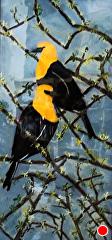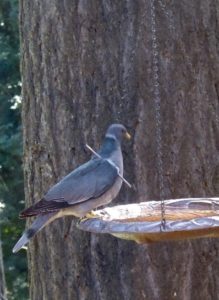 These beautiful birds are protected at the Malheur Wildlife Refuge, yet they risk their lives when traveling to Mexico for the winter. I painted them last spring after taking our annual excursion to view Oregon’s migratory birds. Sorry, but the painting sold.
These beautiful birds are protected at the Malheur Wildlife Refuge, yet they risk their lives when traveling to Mexico for the winter. I painted them last spring after taking our annual excursion to view Oregon’s migratory birds. Sorry, but the painting sold.
 Ray took this picture of the Band-Tailed Pigeon perched on our back porch feeder. Notice the dart (or broken arrow) sticking out of it’s shoulder. This was a courageous bird that managed to make the trip from Mexico north, carrying the projectile the entire distance. It made me wonder why this poor pigeon was treated so poorly so I did a bit of research about killing birds.
Ray took this picture of the Band-Tailed Pigeon perched on our back porch feeder. Notice the dart (or broken arrow) sticking out of it’s shoulder. This was a courageous bird that managed to make the trip from Mexico north, carrying the projectile the entire distance. It made me wonder why this poor pigeon was treated so poorly so I did a bit of research about killing birds.
The Guardian reported that conservationists are appalled at the illegal killing of 25 million birds a year in the Mediterranean alone. Egyptians line beaches with high nets across miles of the Nile Delta . Cypriots stop songbirds by smearing branches with glue, while the Italians kill anything that flies and the French set metal traps for small birds. Though these countries do have strong laws, they are not working. The Guardian mentioned that Italy and Egypt are the most dangerous countries for migratory birds followed by Syria, Lebanon and Cyprus where songbirds are a culinary delicacy.
Advertisers on Google promote dove hunting adventures to countries like Argentina, Uruguay, and Columbia. Hunters are supplied with 1000 free shells, and go on 8 shoots over four days for a cost of $2,600 plus tips. High volume dove shooting is also advertised by South America Adventure Safaris where the most experienced shooters stay in luxurious lodges. These mighty hunters face-off with ducks, pigeons, and doves. Most of the meat goes uneaten by the hunters though the organizers claim the birds supply food to the local community. Since most of birds are shot with lead pellets that become imbedded in their flesh, they are not safe to eat. The pellets also are a hazard to birds, such as hawks, that pick up lead shot from the ground and get poisoned.
I read a blog by a horrified writer who echoes my sentiments. “ I understand the idea of hunting for food or pest control, and I get the idea of hunting for sport but what I don’t get is why someone would go and kill a thousand birds, or a couple dozen. Is it the challenge? Doesn’t seem like a big challenge if some kid can take down a thousand on a weekend? What is the appeal?”
There were many answers.
One person mentioned that Doves eat grain and are considered a plague by farmers for they destroy entire crops in a night. Another boasted that their meat is delicious and hunting is fun, for it occurs when the weather is good as opposed to hunting ducks or geese.
Another answered, “There are a great many things I shoot and kill, yet have zero desire to eat. Moles, feral cats, nutria, rats, field mice, the neighbor’s dogs, voles, starlings … of course possum, raccoon and coyote as well. Crows just aren’t worth the trouble to clean (much like dove), but I hunt them anyway.”
However, one response that did make some sense to me was, “Number 1 rule of hunting . . . you eat what you kill! If you were hungry enough, you’d not only eat dog, you’d fight for the scraps.”
Now I am stymied. My bird feeder attracts lovely feathered creatures that I have come to treasure. The thought of them being killed for sport is demoralizing. The fact that we are wiping out populations of birds and animals on a mass scale I believe is unconscionable. On the other hand, the idea of people going hungry is also unethical. In poor countries, entire populations of wildlife are eliminated because of food insecurity.
What do we as a society do to address hunger as well as the needs of sportsmen? There are very real nutritional as well as recreational needs. Questions of population control, agricultural practices that encourage small farmers, and sharing of resources must be considered. Why can’t hunters have fun shooting drones or skeets instead of living creatures? Surely there must be a way to enjoy life without destroying nature.
